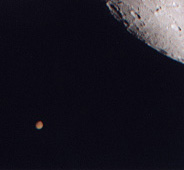Daytime Moon to Eclipse Mars
This month the continental United States will be treated to an eclipse. Is it a lunar eclipse or a solar eclipse? Neither one. On the morning of February 18, the moon will eclipse the planet Mars in broad daylight for the east coast beginning about a half hour after sunrise.
Weather permitting that morning, around the start of nautical twilight at 6 a.m. you will observe the waning crescent moon well placed in the southeast sky. Nearby, and to the moon’s lower left will be the planet Mars, only one lunar diameter away.
To the naked eye the dazzling moon, shining some 30 thousand times brighter than Mars, can make Mars difficult to discern. A pair of binoculars or a small telescope will help make Mars stand out better.
While you’re up looking in twilight take a moment to notice two other planets. To the lower left of the moon, and only half of the moon’s elevation in the sky, is Jupiter. Continuing in the same direction toward Jupiter’s lower left, Saturn hovers just above the horizon (if not obscured by trees, buildings, etc.).
As the hour passes, twilight brightens the sky and the planets fade. Good thing you already spotted Mars and know where to locate it in relation to the moon. Because by the time the sun rises at 6:56 a.m., Mars may no longer be visible to the unaided eye, unless the sky is unusually clear.
In your binoculars or telescope, you will see the gap between moon and Mars has shrank to less than half a lunar diameter. This gap continues to narrow until Mars appears to touch the edge of the moon’s sunlit side, at about 7:27 a.m.
As the moon continues its orbital motion, Mars slowly and completely disappears behind the moon – or as astronomers say, is “occulted” – some 15 seconds later.
Mars begins to reappear along the moon’s unlit side some 92 minutes later at 8:59 a.m. Coming out from behind the moon’s dark edge and away from its dazzling crescent will make detecting it all that much easier. The reappearance – or “egress” – likewise requires around 15 seconds. The reappearance will be more spectacular than the reappearance. Remember to keep your eye peeled so you don’t miss egress.
The moon’s eclipse or occultation of Mars provides a great opportunity to observe a major planet during daytime. The moon makes a good landmark when Mars can be viewed in the same binocular or telescope field.
Once it reappears, try to observe Mars with your naked eye during daylight. Can you see it?

This month Mars has a close encounter with the moon similar to this one in 2003 photographed by the author using a simple point-and-shoot digital camera hand held to the eyepiece of a 12.5” telescope.
Here is a news alert. What is up with the star Betelgeuse, the red supergiant that marks Orion the Hunter’s eastern shoulder? The 1st magnitude star has dimmed noticeably and has astronomers scratching their heads and debating the cause. Begelgeuse (pronounced Bate-el-jewz) is known to be a variable star whose brightness fluctuates over time. Even so, the current change in its brightness is unprecedented.
Christopher Bennett, Westminster Astronomical Society (WASI) president, will provide a summary of the prevailing science and emerging hypotheses behind the star’s sudden decrease in brightness at the next WASI meeting, at 7:30 p.m. on Wednesday, February 12, in the Bear Branch Nature Center’s auditorium, located at 300 John Owings Road. The meeting is free and no registration is required.
–Curt Roelle
